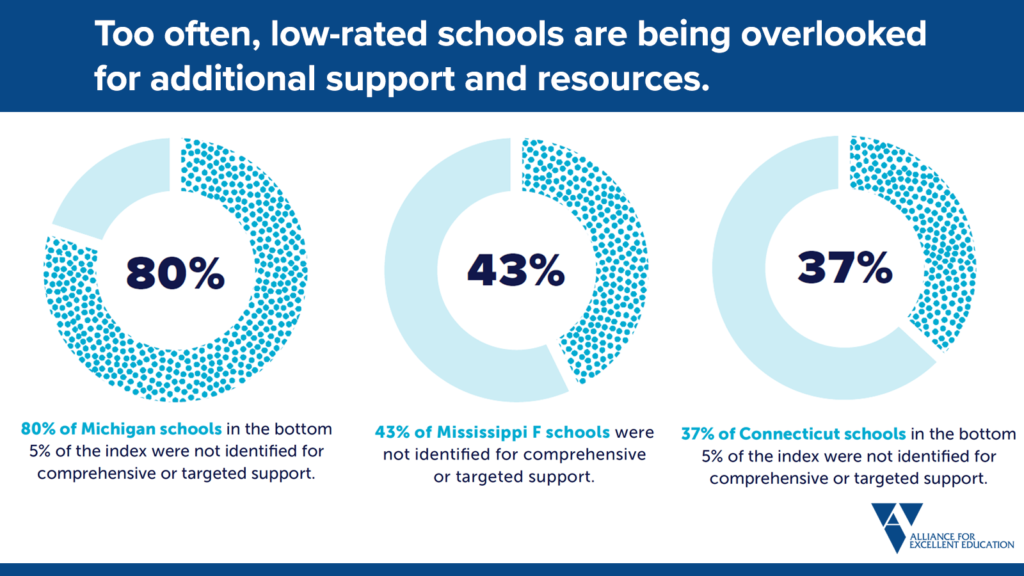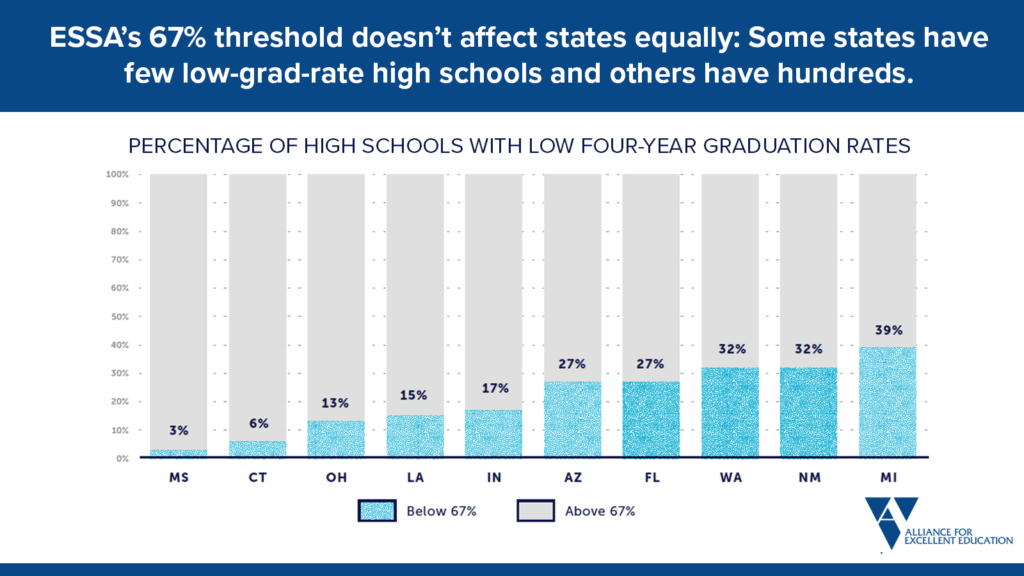When Equity Is Optional
The Every Student Succeeds Act (ESSA) gave states flexibility in designing school accountability systems, while retaining a set of “equity guardrails” to ensure states focus resources on low-performing schools and marginalized students. In our When Equity Is Optional series, we have analyzed data from ESSA implementation across ten states (Arizona, Connecticut, Florida, Indiana, Louisiana, Michigan, Mississippi, New Mexico, Ohio, and Washington) to show how well states have used the law’s opportunities to advance equity and meaningfully improve outcomes for students. Unfortunately, our data show that flexibility and equity are too often in conflict.
Does Accountability Drive School Spending?
ESSA requires states to identify at least the lowest-performing 5% of Title I schools and high schools where fewer than two-thirds of students graduate on time to receive comprehensive support. States must also identify schools with one or more underperforming groups of students to receive targeted support.
Improving these schools and implementing evidence-based interventions requires extra funding. However, in our latest report, When Equity Is Optional: Does Accountability Drive School Spending, we found that many identified schools spent less per pupil after being identified than they did before. We believe accountability results should be reflected in policymakers’ funding decisions and identified schools should receive additional resources.
Results from Early ESSA Implementation
In 2020, five years after ESSA’s passage, it was already clear that students in low-performing schools in different states had very different odds of receiving the support they needed to improve. The variation was especially troubling given that, across all states we examined, students of color were much more likely to attend low-rated schools.
Our analyses—using data from the first year of ESSA implementation in Arizona, Connecticut, Florida, Indiana, Louisiana, Michigan, Mississippi, New Mexico, Ohio, and Washington—found that states have used ESSA’s flexibility to take dramatically different approaches to school ratings and school improvement, often at the expense of students of color and students from low-income backgrounds.
Explore each of the analyses below, or scroll to the bottom of this page for more detail on our findings.
When Equity Is Optional: How State Choices Affect Ratings and Identification for Support under ESSA
When Equity Is Optional: Students of Color More Likely to Attend Low-Rated Schools
When Equity Is Optional: Low-Graduation-Rate High Schools and the 67% Threshold
Learn More About the States
As part of our When Equity Is Optional series, we developed one-page state fact sheets analyzing each state’s school ratings and lists of identified comprehensive and targeted support schools from the first year of ESSA implementation. We found that ratings do not always accurately reflect the performance of historically underserved students or whether the state has identified a school for support. And in several states, many schools with low ratings were overlooked to receive additional help from their state and school district. Find your state below.
Learn More About Our Findings
Click the buttons for each topic below for more about the findings from our When Equity Is Optional series.
Race and School Ratings
Students of Color Disproportionately Attend Low-Rated Schools

School ratings can reveal disparities in the quality of education different groups of students receive. Based on the enrollment of students by race in schools with the highest and lowest ratings under ESSA, students of color do not have equitable access to an excellent education. Black and Latino students were more likely to attend low-rated schools than White students.
School Ratings and Identification
How State Choices Affect Ratings and Identification for Support under ESSA
The likelihood a school was identified for support varied widely by state. Some states identified half, or more, of the public schools they serve, while others identified fewer than 5% of schools. While some states ensured that the lowest-rated schools were consistently identified for support under ESSA, other states made choices that resulted in low-rated schools being overlooked. As a result, students in low-performing schools—who are much more likely to be students of color or from low-income families—in different states have very different odds of receiving the support they need to improve.

Low-Graduation-Rate High Schools
The 67% Threshold

ESSA requires states to identify high schools where fewer than 67% of students graduate for comprehensive support and improvement (CSI). This might seem like a bright-line rule that would affect states similarly, but the likelihood that high schools were identified varied widely—largely due to differences in graduation rates between states but also because of state policy choices that overlook some low-graduation-rate high schools. Reporting a four-year graduation rate below the 67% threshold did not guarantee a high school would be identified.
